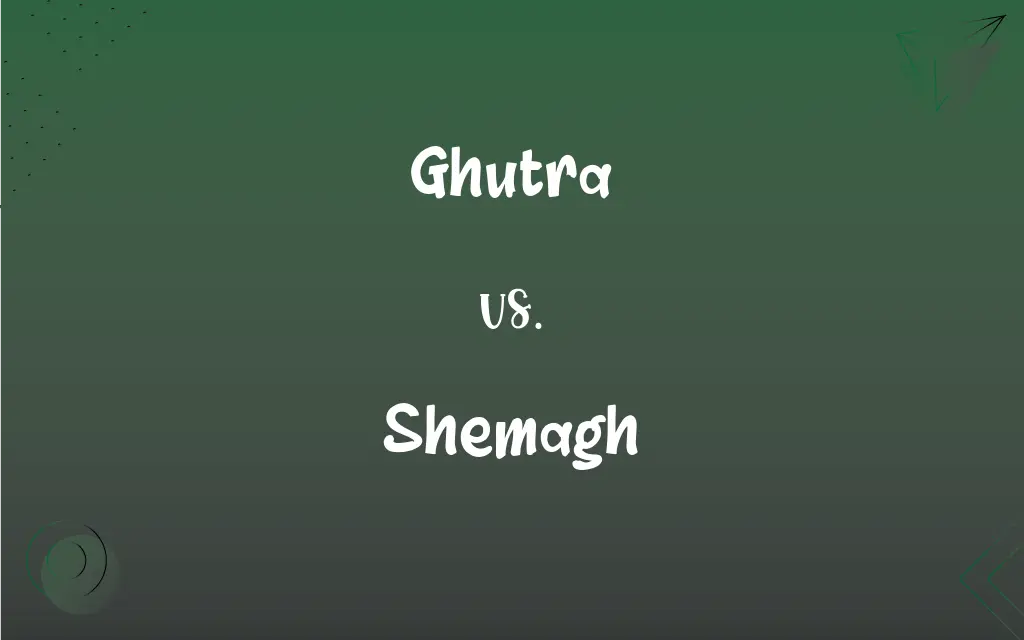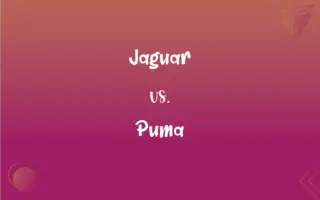Ghutra vs. Shemagh: What's the Difference?
By Harlon Moss & Aimie Carlson || Updated on May 24, 2024
A Ghutra is a traditional Middle Eastern headscarf, typically white and worn by men in the Arabian Peninsula, while a Shemagh is a patterned scarf, often red and white, used across the Middle East and North Africa for practical and cultural purposes.

Key Differences
Ghutra is a traditional headscarf predominantly worn in the Arabian Peninsula, especially in Saudi Arabia, Kuwait, and the UAE. It is usually plain white and made of cotton, symbolizing elegance and simplicity. Shemagh, on the other hand, is a traditional headscarf known for its distinctive checkered pattern, typically in red and white or black and white. It is widely used across the Middle East and North Africa, including countries like Jordan, Palestine, and Iraq.
While both ghutra and shemagh are similar in their primary function as head coverings, the main differences lie in their patterns, cultural significance, and regional usage. Ghutra's plain white design signifies purity and is often associated with formal attire, whereas the shemagh's checkered patterns can carry various cultural and political meanings.
Ghutra tends to be more formal and is often part of traditional attire for official events and ceremonies. Shemagh, with its varied patterns, can also be used in military and casual contexts, providing a versatile option for daily wear and practical uses.
Comparison Chart
Definition
Plain white traditional headscarf
Checkered patterned headscarf
Primary Colors
White
Red and white, black and white
ADVERTISEMENT
Regional Usage
Arabian Peninsula
Middle East and North Africa
Material
Usually cotton
Cotton or wool
Cultural Significance
Symbolizes elegance and simplicity
Symbolizes cultural identity and practicality
Common Usage
Formal attire, official events
Daily wear, military, and practical uses
Ghutra and Shemagh Definitions
Ghutra
A traditional white headscarf worn in the Arabian Peninsula.
The sheikh wore a ghutra to the formal event.
ADVERTISEMENT
Shemagh
Used for practical purposes like protection from the elements.
The shemagh kept the sand out of his face during the desert trek.
Ghutra
Made from cotton, symbolizing simplicity.
The lightweight cotton ghutra is perfect for the hot desert climate.
Shemagh
A checkered patterned headscarf used across the Middle East and North Africa.
The soldier wrapped his shemagh around his head to protect against the sun.
Ghutra
Typically held in place with an agal.
He adjusted his ghutra and secured it with an agal before entering the meeting.
Shemagh
Comes in various colors, most commonly red and white or black and white.
He chose a red and white shemagh to match his traditional outfit.
Ghutra
Part of traditional attire for men.
He dressed in a thobe and ghutra for the wedding ceremony.
Shemagh
Symbolizes cultural identity and can carry political significance.
The black and white shemagh is a symbol of Palestinian heritage.
Ghutra
Associated with formality and tradition.
The ghutra is often seen at official functions and gatherings.
Shemagh
Made from cotton or wool, suitable for various climates.
The wool shemagh provided warmth during the chilly nights.
Ghutra
Variant of gutra.
Shemagh
See keffiyeh.
Ghutra
A type of headcloth, a keffiyeh.
Shemagh
A headcloth designed for a desert environment to protect the wearer from sand and heat.
FAQs
What is a ghutra?
A ghutra is a traditional plain white headscarf worn mainly in the Arabian Peninsula.
Where is the ghutra commonly worn?
The ghutra is commonly worn in countries like Saudi Arabia, Kuwait, and the UAE.
Where is the shemagh commonly worn?
The shemagh is commonly worn in Jordan, Palestine, Iraq, and other Middle Eastern and North African countries.
What material is a ghutra made of?
A ghutra is usually made of cotton.
What colors are typical for a ghutra?
The ghutra is typically plain white.
What colors are typical for a shemagh?
The shemagh commonly features checkered patterns in red and white or black and white.
Is the ghutra formal or casual?
The ghutra is more formal and is often part of traditional attire for official events.
What material is a shemagh made of?
A shemagh can be made of cotton or wool.
What is a shemagh?
A shemagh is a checkered patterned headscarf widely used across the Middle East and North Africa.
Does the shemagh have cultural significance?
Yes, the shemagh symbolizes cultural identity and can carry political significance.
How is the ghutra typically worn?
The ghutra is typically worn with an agal to hold it in place.
Is the shemagh formal or casual?
The shemagh can be both formal and casual, used in daily wear, military contexts, and practical purposes.
Can women wear a ghutra?
Traditionally, the ghutra is worn by men, but women may wear similar head coverings.
Can women wear a shemagh?
Yes, women can wear a shemagh, especially for practical purposes like protection from the elements.
How is the shemagh typically worn?
The shemagh is wrapped around the head and face for protection from the sun, wind, and sand.
What is the significance of the agal?
The agal is a black cord used to secure the ghutra on the head.
Does the ghutra have cultural significance?
Yes, the ghutra symbolizes elegance and simplicity and is associated with tradition.
Is the ghutra suitable for all climates?
The lightweight cotton ghutra is particularly suitable for hot climates.
Is the shemagh suitable for all climates?
The shemagh is versatile and can be made from different materials to suit various climates.
What practical uses does the shemagh have?
The shemagh is used for protection against sun, wind, and sand, and can also serve as a makeshift towel, sling, or scarf.
About Author
Written by
Harlon MossHarlon is a seasoned quality moderator and accomplished content writer for Difference Wiki. An alumnus of the prestigious University of California, he earned his degree in Computer Science. Leveraging his academic background, Harlon brings a meticulous and informed perspective to his work, ensuring content accuracy and excellence.
Co-written by
Aimie CarlsonAimie Carlson, holding a master's degree in English literature, is a fervent English language enthusiast. She lends her writing talents to Difference Wiki, a prominent website that specializes in comparisons, offering readers insightful analyses that both captivate and inform.
































































